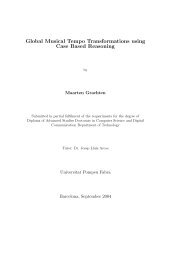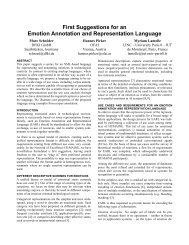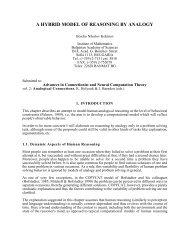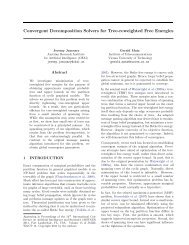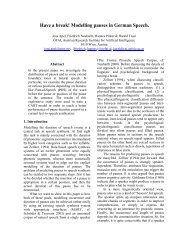Computational Models of Music Similarity and their ... - OFAI
Computational Models of Music Similarity and their ... - OFAI
Computational Models of Music Similarity and their ... - OFAI
Create successful ePaper yourself
Turn your PDF publications into a flip-book with our unique Google optimized e-Paper software.
20 2 Audio-based <strong>Similarity</strong> Measures<br />
The power spectrum is transformed to the Mel-scale using a filter bank<br />
consisting <strong>of</strong> triangular filters. Each triangular filter defines the response <strong>of</strong><br />
one frequency b<strong>and</strong> <strong>and</strong> is normalized such that the sum <strong>of</strong> weights for each<br />
triangle is the same. In particular, the height <strong>of</strong> each triangle is 2/d where<br />
d is the width <strong>of</strong> the frequency b<strong>and</strong>. The triangles overlap each other such<br />
that the center frequency <strong>of</strong> one triangle is the starting point for the next<br />
triangle, <strong>and</strong> the end point <strong>of</strong> the previous triangle (see Figure 2.5).<br />
The triangular filters can be computed in Matlab as follows. 10 First, the<br />
variables are initialized <strong>and</strong> memory allocated.<br />
01 num_filt = 36; %% number <strong>of</strong> Mel frequency b<strong>and</strong>s (2.4)<br />
02<br />
03 f = linspace(0,fs/2,seg_size/2+1); %% frequency bins <strong>of</strong> P<br />
04 mel = log(1+f/700)*1127.01048;<br />
05 mel_idx = linspace(0,mel(end),num_filt+2);<br />
06 mel_filter = zeros(num_filt,seg_size/2+1);<br />
07<br />
08 f_idx = zeros(num_filt+2,1);<br />
09 for i=1:num_filt+2,<br />
10 [tmp f_idx(i)] = min(abs(mel - mel_idx(i)));<br />
11 end<br />
12 freqs = f(f_idx);<br />
13<br />
14 %% height <strong>of</strong> triangles<br />
15 h = 2./(freqs(3:num_filt+2)-freqs(1:num_filt));<br />
Second, in the main loop for each triangular filter the weights are computed.<br />
16 for i=1:num_filt, (2.5)<br />
17 mel_filter(i,:) = ...<br />
18 (f > freqs(i) & f freqs(i+1) & f < freqs(i+2)).* ...<br />
21 h(i).*(freqs(i+2)-f)/(freqs(i+2)-freqs(i+1));<br />
22 end<br />
10 This code is based on Malcolm Slaney’s Auditory Toolbox.




